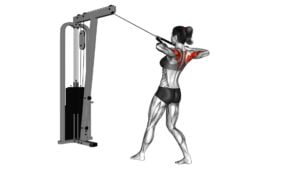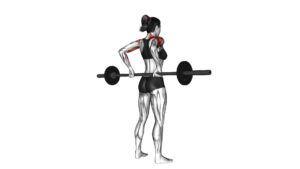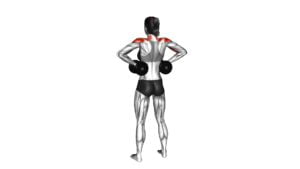Cable Seated Rear Delt Raise (female) – Video Exercise Guide & Tips

Looking to strengthen and tone your rear deltoids? Look no further than the Cable Seated Rear Delt Raise.
Watch This Exercise Video
This exercise targets the muscles in the back of your shoulders, helping to improve posture and enhance overall upper body strength.
In this video exercise guide, you'll find step-by-step instructions and helpful tips to ensure proper form and maximize your results.
So grab a cable machine and get ready to sculpt those deltoids like never before!
Key Takeaways
- Targets the muscles in the back of the shoulders
- Improves posture
- Enhances overall upper body strength
- Increases shoulder stability
Benefits of Cable Seated Rear Delt Raise
Improve your shoulder strength and posture with the cable seated rear delt raise, a highly effective exercise that targets the posterior deltoids. The cable seated rear delt raise primarily works the posterior deltoids, which are the muscles located at the back of your shoulders. By targeting these muscles, you can improve your shoulder stability and overall upper body strength.
To perform the cable seated rear delt raise, start by sitting on a bench facing a cable machine. Grab the cable handles with an overhand grip, palms facing down. Keep your back straight and engage your core. Slowly raise your arms out to the sides, keeping a slight bend in your elbows. Focus on squeezing your shoulder blades together as you lift the cables. Pause for a moment at the top, then slowly lower your arms back down to the starting position.
Incorporating cable seated rear delt raises into your workout routine can help you achieve a balanced upper body and improve your posture. You can perform this exercise as part of your shoulder or upper body workout, or even as a standalone exercise. Aim for 3-4 sets of 10-12 repetitions, gradually increasing the weight as you get stronger. Remember to maintain proper form throughout the exercise to maximize its benefits and prevent injury.
Equipment Needed for Cable Seated Rear Delt Raise
To perform the cable seated rear delt raise, you'll need a cable machine and a bench. These two pieces of equipment are essential for targeting and strengthening your rear deltoid muscles effectively. The cable machine provides resistance throughout the exercise, allowing you to build strength and definition in your rear delts.
When it comes to cable seated rear delt raise variations, you have a few options. You can use a low cable machine, where the cable is positioned at the lowest setting. Alternatively, you can use a high cable machine, where the cable is positioned at the highest setting. Both variations provide slightly different angles of resistance, targeting your rear delts from different angles and maximizing muscle activation.
In addition to the cable machine, a bench is crucial for this exercise. The bench provides stability and support, allowing you to maintain the correct posture throughout the movement. It also ensures that your back remains straight and your core engaged, preventing any strain or injury.
Now that you know the equipment needed for cable seated rear delt raise, let's move on to the next section, where we'll discuss the proper form and technique for this exercise.
Proper Form and Technique for Cable Seated Rear Delt Raise
To perform the cable seated rear delt raise with proper form and technique, you should:
- Position yourself on the bench and grasp the cable handle.
- Sit upright with your feet flat on the floor and your knees slightly bent.
- Keep your core engaged and your back straight throughout the exercise.
- Begin by retracting your shoulder blades and pulling the cable towards your body.
- Focus on squeezing your rear deltoid muscles, which are located at the back of your shoulders.
- Avoid using momentum or swinging your body to lift the weight.
- Maintain control and perform the movement in a slow and controlled manner.
- This will ensure that your rear deltoids are properly engaged and that you're getting the most out of the exercise.
Common mistakes to avoid include:
- Using too much weight and sacrificing form.
- Hunching your back or rounding your shoulders.
- Not fully retracting your shoulder blades.
It's important to remember that proper form and technique are key to maximizing muscle activation and minimizing the risk of injury.
Now that you know the proper form and technique for the cable seated rear delt raise, let's move on to discussing variations and modifications for this exercise.
Variations and Modifications for Cable Seated Rear Delt Raise
For additional challenge and targeting different areas of the shoulders, you can try different variations and modifications of the cable seated rear delt raise exercise. By incorporating these variations, you can keep your shoulder workouts fresh and continue to make progress.
One variation you can try is the single-arm cable seated rear delt raise. Instead of using both arms simultaneously, you'll perform the exercise one arm at a time. This not only increases the difficulty but also allows you to focus on each side of your shoulders individually.
Another modification you can make is adjusting the height of the cable machine. By raising or lowering the pulley, you can target different parts of your shoulders. For example, raising the pulley will emphasize the rear delts, while lowering it will engage the upper back muscles more.
Lastly, you can also experiment with different grips. Instead of using a neutral grip, you can try a pronated or supinated grip to change the angle of the exercise and activate different muscles.
Tips for Maximizing Results With Cable Seated Rear Delt Raise
To maximize your results with the cable seated rear delt raise, focus on maintaining proper form and engaging the muscles of your shoulders throughout the entire exercise. This will ensure that you're targeting the correct muscles and maximizing the effectiveness of the exercise.
One common mistake that people make with the cable seated rear delt raise is using too much weight. It's important to start with a weight that you can comfortably lift and then gradually increase the weight as you get stronger. Using too much weight can lead to poor form and increase the risk of injury.
Another common mistake is using momentum to lift the weight. Instead, focus on using controlled movements and really squeeze your shoulder muscles at the top of the movement. This will help to fully engage the muscles and maximize the results.
For optimal results, it's recommended to perform 3-4 sets of 8-12 reps of the cable seated rear delt raise. This rep range allows for both strength and hypertrophy training, helping to build both strength and muscle size in your shoulders.
Frequently Asked Questions
How Many Sets and Reps Should I Do for Cable Seated Rear Delt Raise?
To determine the number of sets and reps for the cable seated rear delt raise, you should consider your fitness goals and current fitness level. Generally, it's recommended to perform 3-4 sets of 8-12 reps for muscle growth and strength.
However, you can adjust the sets and reps based on your preferences and capabilities. Remember, there are alternative exercises available to target the rear deltoids, and the cable seated rear delt raise specifically helps improve shoulder stability and posture.
Can Cable Seated Rear Delt Raise Help With Shoulder Impingement?
To prevent shoulder impingement during exercises, it's important to choose alternative exercises that don't exacerbate the condition. Look for exercises that focus on strengthening the rotator cuff and improving shoulder stability.
Incorporating exercises like external rotations, lateral raises, and face pulls can help alleviate shoulder impingement. Additionally, maintaining proper form, avoiding excessive weight, and listening to your body's signals can also help prevent shoulder impingement during exercises.
Is It Necessary to Use a Cable Machine for This Exercise, or Can It Be Done With Dumbbells or Resistance Bands?
Using a cable machine for the Cable Seated Rear Delt Raise isn't necessary. You have alternatives like using dumbbells or resistance bands. However, using a cable machine has its benefits. It provides constant tension throughout the movement, targeting your rear delts effectively.
On the other hand, resistance bands offer versatility and can be easily adjusted for different levels of resistance. So, if you don't have access to a cable machine, don't worry. You can still achieve great results with dumbbells or resistance bands.
Can Cable Seated Rear Delt Raise Be Performed by Beginners or Is It More Suitable for Advanced Gym-Goers?
Cable seated rear delt raise can be performed by beginners and advanced gym-goers alike. This exercise provides several benefits, such as targeting the rear delts to improve shoulder strength and posture.
For beginners, it's important to start with lighter weights and focus on proper form. If you don't have access to a cable machine, you can modify this exercise using dumbbells or resistance bands. However, cable machines offer a unique tension and stability that can enhance the effectiveness of the exercise.
Are There Any Common Mistakes to Avoid When Performing Cable Seated Rear Delt Raise?
When performing cable seated rear delt raise, it's important to avoid common mistakes for proper form.
Firstly, make sure to maintain a straight back and engage your core throughout the exercise. Avoid using momentum and focus on controlled movements to target the rear delts effectively.
Additionally, avoid shrugging your shoulders and keep them relaxed.
Lastly, adjust the weight and cable height to suit your fitness level and prevent any strain or injury.
Conclusion
To conclude, the cable seated rear delt raise is a highly effective exercise for targeting and strengthening the rear deltoid muscles. By using the cable machine, you can adjust the resistance and ensure constant tension on the muscles throughout the movement.
Remember to maintain proper form and technique, and consider incorporating variations and modifications to keep challenging your muscles.
With consistent practice and proper form, you can maximize your results and achieve stronger and more defined rear deltoids.

Author
Years ago, the spark of my life’s passion ignited in my mind the moment I stepped into the local gym for the first time. The inaugural bead of perspiration, the initial endeavor, the very first surge of endorphins, and a sense of pride that washed over me post-workout marked the beginning of my deep-seated interest in strength sports, fitness, and sports nutrition. This very curiosity blossomed rapidly into a profound fascination, propelling me to earn a Master’s degree in Physical Education from the Academy of Physical Education in Krakow, followed by a Sports Manager diploma from the Jagiellonian University. My journey of growth led me to gain more specialized qualifications, such as being a certified personal trainer with a focus on sports dietetics, a lifeguard, and an instructor for wellness and corrective gymnastics. Theoretical knowledge paired seamlessly with practical experience, reinforcing my belief that the transformation of individuals under my guidance was also a reflection of my personal growth. This belief holds true even today. Each day, I strive to push the boundaries and explore new realms. These realms gently elevate me to greater heights. The unique combination of passion for my field and the continuous quest for growth fuels my drive to break new ground.







